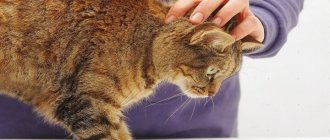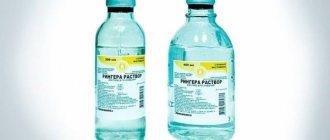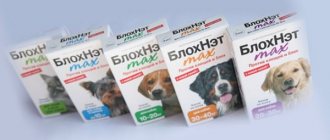Dosage form
Piro-Stop® is an injection solution
in sterile vials. The drug (1 ml) consists of the active substance and contains imidocarb dipropionate - 120.0 mg.
One ml of the drug contains excipients:
- water for injection - up to 1.0 ml
- polyvinylpyrrolidone - 10.0 mg
- propionic acid - 30.0 mg
- benzyl alcohol - 9.0 mg
Piro-Stop belongs to the group of antiprotozoal drugs.
The active pharmacological ingredient of the drug "Piro-Stop" is imidocarb dipropionate.
Piro-Stop is an injectable antiparasitic drug for the treatment of antiparasitic infestations (hemosporidiosis) in dogs and other animal species. Its active component is imidocarb dipropionate, which is chemically classified as a carbanilide derivative.
Piro-Stop for injection is recommended for the treatment of anaplasmosis, piroplasmosis and ehrlichiosis
caused by protozoa and rickettsia.
Imidocarb is primarily used to treat large Babesia and Hepatozone infestations in dogs. More effective protoprotozoal drugs have replaced imidocarb for the treatment of monocytic ehrlichiosis in dogs and cytauxoonosis in cats. Piro-Stop is an etiotropic treatment for piroplasmosis in dogs and other animal species.
Characteristics of the drug
The clear, yellow liquid is a 12% imidocarb solution. The drug is packaged in dark glass bottles of 10; 20; 100 ml.
The cost of 10 ml in August 2021 is 567 rubles.
Imidocarb prevents the entry of a vital component, inositol, into the parasite cell. After injection, the active substance is accumulated by the liver and kidneys. Antiprotozoal concentration in the blood is maintained for 4 to 6 weeks. It is excreted from the body mainly in urine.
Pharmacological properties
According to the instructions for use, the drug Pirostop is effective against a whole range of pathogens - causative agents of hemosporidiosis in animals:
- Anaplasma marginale
- Anaplasma ovis
- Babesia bigemina
- Babesia bovis
- Babesia caballi
- Babesia canis
- Babesia colchica
- Babesia divergens
- Babesia equi
- Babesia gibsoni
- Babesia ovis
- Ehrlichia canis
- Francaiella colchica
- Nuttallia equi
- Theileria annulata
- Theileria mutans
- Theileria orientalis
- Theileria ovis
- Theileria recondita
- Theileria sergenti
- Theileria tarandirangiferis
The use of the drug is possible for prophylactic purposes when administered to susceptible animals in high-risk areas.
Piro-Stop® injection helps control fever while improving exercise performance in the affected animal.
Pirostop circulates in the animal’s body for a long time, which means a longer period of protection.
Dosage of the drug Piro-Stop
The drug is prescribed parenterally - subcutaneously or intramuscularly.
Doses for dogs are given in Table 1.
Table 1 - Application and dosage of the drug PiroStop® for dogs
| Body weight, kg | Minimum dose of the drug, ml | Body weight, kg | Maximum dose of pyrostop, ml | Body weight, kg | Minimum dose of the drug, ml |
| 1 | 0,025 | 0,05 | 18 | 0,45 | 0,9 |
| 2 | 0,05 | 0,1 | 20 | 0,5 | 1 |
| 3 | 0,075 | 0,15 | 23 | 0,575 | 1,15 |
| 4 | 0,1 | 0,2 | 25 | 0,625 | 1,25 |
| 5 | 0,125 | 0,25 | 27 | 0,675 | 1,35 |
| 6 | 0,15 | 0,3 | 30 | 0,75 | 1,5 |
| 7 | 0,175 | 0,35 | 35 | 0,875 | 1,75 |
| 8 | 0,2 | 0,4 | 40 | 1 | 2 |
| 9 | 0,225 | 0,45 | 45 | 1,125 | 2,25 |
| 10 | 0,25 | 0,5 | 50 | 1,25 | 2,5 |
| 11 | 0,275 | 0,55 | 55 | 1,375 | 2,75 |
| 12 | 0,3 | 0,6 | 60 | 1,5 | 3 |
| 13 | 0,325 | 0,65 | 65 | 1,625 | 3,25 |
| 15 | 0,375 | 0,75 | 70 | 2 | 4 |
According to recent studies, the drug "PiroStop" can be prescribed to cats. Toxicological studies have not confirmed the high toxicity of Piro-Stop for the body of cats.
Table 2 - Use of pyrostop for cats
| Weight, kg | Dose of Piro-Stop, ml |
| 1 | 0,04 |
| 2 | 0,08 |
| 3 | 0,12 |
| 4 | 0,16 |
| 5 | 0,2 |
| 6 | 0,24 |
| 7 | 0,28 |
| 8 | 0,32 |
Table 3 - Dose of Piro-STOP for cattle, horses, donkeys for the treatment of babesiosis
| Weight, kg | Drug dose, ml |
| 100 | 2,0 |
| 200 | 4,0 |
| 300 | 6,0 |
| 400 | 8,0 |
| 500 | 10,0 |
| 600 | 12,0 |
| 700 | 14,0 |
Table 4 - Dose of the drug “Piro-Stop” for sheep for the treatment of babesiosis
| Weight, kg | Drug dose, ml |
| 10 | 0,20 |
| 20 | 0,40 |
| 30 | 0,60 |
| 40 | 0,8 |
| 50 | 0,1 |
| 60 | 0,12 |
Pyro-stop for dogs: instructions for use
According to the instructions for use, before administering the Piro-Stop solution, it is necessary to treat the injection site with an antiseptic drug, which can be 70% medical alcohol or calendula alcohol tincture. Important! For dogs with very sensitive skin, as well as those with skin diseases, it is better to use Octeniderm or its analogues.
Where to inject the medicine
Veterinary experts do not recommend injecting Piro-Stop solution yourself. But such a need may arise in case of excessive distance from the clinic (on vacation in a forest area or mountainous area), as well as in the acute form of piroplasmosis, when every minute is valuable.
Important! When going on vacation to places where it is impossible to quickly get to a veterinary clinic, you should take the drug with you. In this case, you need to place it in a thermal bag to prevent freezing or heating above +25©.
You should first ask your veterinarian how and where to inject Piro-Stop in order to avoid the manifestation of a local reaction in the form of tissue inflammation at the injection site. The medicine is injected subcutaneously into the neck or intramuscularly into the muscles of the hind limb.
In most cases, experts prefer subcutaneous injection. This is due to less painful injection, more uniform and slower penetration of the substance into the blood, as well as minimizing the risk of an inflammatory and allergic reaction.
Dosage
After diagnosis, Piro-Stop is administered to the animal once at a dosage of 0.25-0.5 cm3 per 10 kg of live weight. For large breed dogs, the maximum permissible volume of the drug per 1 injection is 2.5 cm3. If the pet's weight is more than 100 kg (St. Bernards, Pyrenees, English and Spanish mastiffs, Boerboels, Newfoundlands), then the decision on exceeding the dose is made by the veterinarian. In this case, the total amount of solution is divided into 2 parts and injected into different areas.
Overdose
The danger of overdose lies in the development of the following complications:
- a sharp decrease in heart rate;
- increased breathing, shortness of breath without physical exertion;
- salivation or lacrimation;
- frequent or involuntary bowel movements and urination;
- muscle tremors or brief tetanic spasms.
Subcutaneous administration of a 1% atropine solution will help relieve an attack.
Side effects
But in some cases, the above symptoms occur even when the dosage is strictly followed. This is explained by the manifestation of an allergic reaction of the dog’s body to the drug.
The administration of antihistamines before the Piro-Stop injection will help minimize the risk of side effects. Only a veterinarian should prescribe and calculate their dosage, taking into account the weight, breed and physiological state of the animal.
Important! Suprastin is prohibited for puppies and small breed dogs due to its negative effects on the liver, kidneys and other internal organs. Preference should be given to second and third generation antihistamines. Among first-generation drugs, Diazolin is allowed to be used with precise dosage.
In severe cases of the disease and the presence of a large number of blood parasites, after using Pyro-Stop, their mass death occurs, causing intoxication in the animal. Intravenous injections of saline solution with glucose, as well as drugs that support liver function, will help eliminate this condition.
Therefore, in case of a severe form of the disease, it is advisable to leave the dog in the clinic under the supervision of a specialist after the Piro-Stop injection..
Soreness, lumps and other local reactions
Compliance with antiseptic rules, the use of disposable sterile syringes and correct injection in most cases ensures the absence of a local inflammatory reaction. But due to the nature of the drug itself and the individual sensitivity of the dog, a small lump or painful redness may form at the injection site, which goes away on its own within 1-2 days.
If after this period the redness and swelling does not subside, but is complicated by an increase in local temperature and severe pain, then the animal should be shown to a doctor.
Use of Piro-Stop for pregnant and lactating females
When wondering about the possibility of using Piro-Stop for pregnant females, you should understand that the lack of treatment will inevitably lead to death. Therefore, if piroplasmosis is confirmed by laboratory tests, then injections of an antiprotozoal agent are a necessity for any physiological condition of the animal.
According to studies, Piro-Stop does not lead to termination of pregnancy, fetal death or the development of abnormalities. These phenomena can appear as a result of severe intoxication and a critical decrease in the level of oxygen in the blood, leading to fetal hypoxia.
Before administering the drug to a lactating female, the puppies are weaned and transferred to artificial feeding.
Features of using Piro-Stop in animals
- Do not use Piro-Stop simultaneously with cholinesterase inhibitors, pesticides and chemicals.
- Do not use the endovenous route of drug administration.
- If the dose is exceeded, pain, swelling and cholinesterase inhibition effects may occur, such as: lethargy, anorexia and salivation; There is rarely ulceration at the injection site and diarrhea. For severe cholinergic symptoms, treat with atropine sulfate as antidote.
- The effectiveness of treatment in puppies has not been determined. The effect of the drug on the animal’s body during pregnancy has not been studied.
Side effects
Provided that manipulations are performed correctly according to the rules of asepsis, local inflammatory reactions are usually not observed. In rare cases, hyperemia and painful swelling of the area where the vaccine was administered may occur. Such phenomena usually do not require specific treatment and disappear without additional intervention within 1-2 days.
Increased individual sensitivity or exceeding recommended dosages may result in the development of the following side effects:
- increased or impaired breathing without physical activity;
- increased heart rate (bradycardia);
- frequent urination and bowel movements;
- increased salivation and lacrimation;
- allergic reactions;
- muscle tremors;
- anorexia;
- increased sweating.
In case of cardiac or respiratory failure, a subcutaneous injection of atropine sulfate at a concentration of 1% is immediately given. If other side effects occur, symptomatic therapy is carried out, including to reduce the body's sensitivity to the action of Pirostop using desensitizing agents.
One of the possible side effects when using Pirostop is intoxication of the body. It develops against the background of massive death of blood parasites and destruction of red blood cells with a strong degree of infection. For such manifestations, intensive therapy with the prescription of sorbents, hepatoprotectors and intravenous administration of electrolytic solutions is recommended.
Storage of the drug
According to the instructions, the pyrostop should be stored in a cool and dry place.
, protected from light, at a temperature of 15º to 30 ºC. Keep out of the reach of children and pets.
Consult your veterinarian before using the drug. Only by prescription - veterinarian.
Piro-Stop is administered intramuscularly, twice, every 2 weeks.
The drug is generally well tolerated, although it may cause short-term pain at the injection site.
According to the instructions, it is prohibited to use the drug for 1 month after vaccination with a live vaccine against anaplasmosis or babesiosis. Since the immunity in these diseases is “non-sterile”.
Acute side effects are due to its anticholinergic activity and include vomiting, shakiness, hypersalivation, lacrimation, diarrhea, agitation, lethargy, pyrexia, and periorbital edema. They usually resolve within a few hours.
There is a possible association between imidocarb treatment and acute renal tubular necrosis in dogs.
Liver necrosis has been described after dogs were overdosed 10 times the recommended dose.
Side effects and contraindications, special instructions
Contraindications:
- Contraindicated for injection in animals sensitive to the substances of this drug.
- It is prohibited to use medicinal medicine for 4 weeks after vaccinations against babesiosis and anaplasmosis.
- It is prohibited to use medicinal drugs together with organochlorine and organophosphorus drugs.
- After using the medicine, slaughtering animals for meat is permitted no earlier than 29 days later.
Side effects:
No side effects were detected after the first injection.
Any side effects after injection of the drug do not appear with rare exceptions in the form of swelling, as well as hyperemia, which disappears after 2-3 days.











